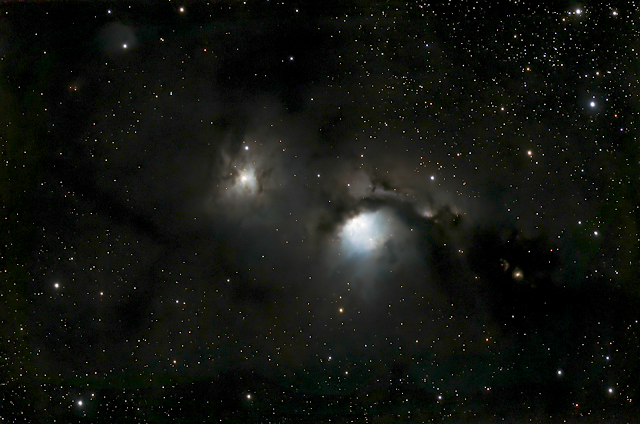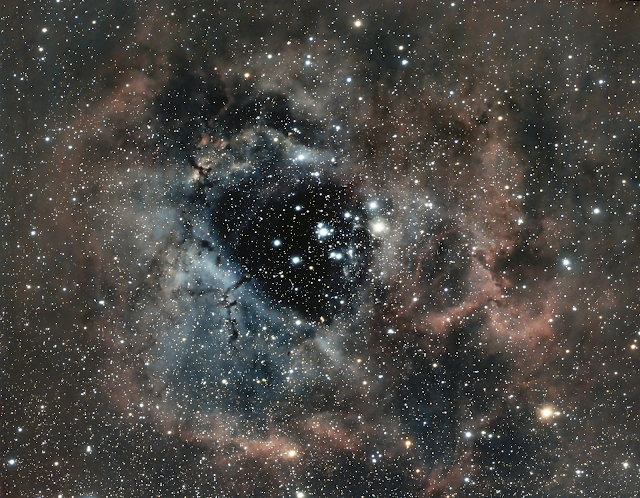Here's the second of my three initial posts looking at some of my astrophotograpy from the Celestron Origin smart telescope. Today, its nebulae. Star clusters will be next.
Let's start off with a popular target from the Northern Hemisphere's winter skies: the Horsehead Nebula.
That's the Horsehead Nebula, also known as Barnard 33, at center. It's a dark cloud that's in front of a red cloud of hydrogen gas that lies some 1,300 light years from Earth. To the left of it is a blue-white reflection nebula known as NGC 2023. In the upper left is the Flame Nebula (NGC 2024) and immediately to the right of that is the star known as Alnitak. Alnitak is the left-most star of Orion's Belt.
Almost three degrees to the east of the Horsehead is Messier 78, an amazing complex of both dark and reflection nebulae located at about the same distance from Earth as the Horsehead Nebula.
M78 is at center and NGC 2071 to the left, but clearly they are part of the same region of space. Both have stars embedded within clouds of gas and dust.
The Rosette Nebula in Monoceros is much larger than the Origin's field of view but I shot a series of overlapping images to create this mosaic.
This is a region of star formation that has an open star cluster (NGC 2244) at center that's surrounded by a ring of glowing hydrogen gas that's leftover from its formation.No visit to the winter skies would be complete without a look at Messier 42, the Great Nebula in Orion.
M42 is almost too bright, but I think that this image captures it nicely. You can see clouds of dark nebulae, blue reflection nebulae and red hydrogen gas.Planetary nebulae are created when a Sun-like star that has evolved into a red giant sheds its outer layers into space.
Messier 27, the Apple Core Nebula is one of the brighter planetary nebulae:
It's located about 1,200 light years from Earth in the direction of the constellation of Vulpecula, the Fox.
Unlike any of the previous images in this post, this image was taken using the nebula filter that Celestron sells to go along with the Origin. The remaining images here also make use of the nebula filter, including the Helix Nebula below:
The Helix another planetary nebula and is about half as far away as M27, which is why it is larger in the sky.Great targets for summer evenings include Messier 16, the famous Eagle Nebula:
At the center of the Eagle nebula lies the famous "Pillars of Creation" that has been photographed by both the Hubble and Webb Space Telescopes. The pillar-shaped dark features at center within this nebula are a part of this nebula which is creating a new cluster of stars.
At the end of their lives massive stars explode as creating supernovae. A supernova is an expanding cloud of star guts. The Veil Nebula is a part of the Cygnus Loop supernova remnant. The western part of the Veil shown here is also sometimes called the Witch's Broom Nebula:
The supernova that created the Veil Nebula exploded between ten and twenty thousand years ago.A star that has not yet exploded, but someday will, is Wolf-Rayet 136, a massive star that has shed some of its gas creating what is known as the Crescent Nebula (NGC 6888):
That's WR 136 at center. It lies some 5,000 light years from Earth and when it explodes it will be bright enough to be seen in the daytime. Alas, we don't expect this to happen anytime soon.Finally, here's perhaps my favorite nebula, Messier 8, the Lagoon Nebula in Sagittarius:
Like M42 above, if you are observing in an area free from light pollution the Lagoon Nebula is just visible to the eye. Through a telescope its a grayish cloud associated with an open star cluster.There's a famous image of the Lagoon Nebula that was one of the first color images of space. It taken before I was born with the 200-inch Hale Telescope at Palomar Observatory. You can see it on my old Palomar Skies blog from when I worked at the observatory.










Thank you, it was like going to an art gallery for a special exhibit with explanations!
ReplyDelete